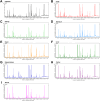Comprehensive Analysis of Metabolic Changes in Mice Exposed to Corilagin Based on GC-MS Analysis
- PMID: 39867865
- PMCID: PMC11762444
- DOI: 10.2147/DDDT.S482510
Comprehensive Analysis of Metabolic Changes in Mice Exposed to Corilagin Based on GC-MS Analysis
Abstract
Background: Corilagin is widely distributed in various medicinal plants. In recent years, numerous pharmacological activities of Corilagin have been reported, including anti-inflammatory, antiviral, hepatoprotective, anti-tumor, and anti-fibrosis effects. However, there is still a need for systematic metabolomics analysis to further elucidate its mechanisms of action. The aim of this study was to explore the pharmacological mechanism of Corilagin.
Methods: This study utilized gas chromatography-mass spectrometry (GC-MS) to analyze central target tissues, comprehensively exploring the pharmacological mechanism of Corilagin in mouse models. We identified the differential metabolites by multivariate analyses, which include principal component analysis (PCA) and orthogonal partial least squares discriminant analysis (OPLS-DA). Using MetaboAnalyst 5.0 and the KEGG database was used to depict the 12 key metabolic pathways.
Results: Compared with the control group, the Corilagin induced 20, 9, 11, 7, 16, 19, 14, 15, and 16 differential metabolites in the intestine, lung, kidney, stomach, heart, liver, hippocampus, cerebral cortex, and serum, respectively. And 12 key pathways involving glucose metabolism, lipid metabolism, and amino acid metabolism were identified following Corilagin treatment.
Conclusion: This research provides insight into the action mechanism of Corilagin's anti-oxidative, anti-inflammatory, anti-atherosclerotic, hepatoprotective, anti-tumor, and neuroprotective properties.
Keywords: Corilagin; amino acids; gas chromatography-mass spectrometry; metabolomics; pharmacological mechanism.
© 2025 Xu et al.
Conflict of interest statement
The authors report no conflicts of interest in this work.
Figures







Similar articles
-
Metabolic profiling analysis of corilagin in vivo and in vitro using high-performance liquid chromatography quadrupole time-of-flight mass spectrometry.J Pharm Biomed Anal. 2019 Feb 20;165:251-260. doi: 10.1016/j.jpba.2018.12.013. Epub 2018 Dec 10. J Pharm Biomed Anal. 2019. PMID: 30562708
-
Corilagin alleviated intestinal ischemia-reperfusion injury by modulating endoplasmic reticulum stress via bonding with Bip.Phytomedicine. 2024 Dec;135:156011. doi: 10.1016/j.phymed.2024.156011. Epub 2024 Sep 6. Phytomedicine. 2024. PMID: 39265205
-
Corilagin Ameliorates Con A-Induced Hepatic Injury by Restricting M1 Macrophage Polarization.Front Immunol. 2022 Jan 13;12:807509. doi: 10.3389/fimmu.2021.807509. eCollection 2021. Front Immunol. 2022. PMID: 35095894 Free PMC article.
-
A GC-MS-based untargeted metabolomics approach for comprehensive metabolic profiling of vancomycin-induced toxicity in mice.Heliyon. 2022 Jul 6;8(7):e09869. doi: 10.1016/j.heliyon.2022.e09869. eCollection 2022 Jul. Heliyon. 2022. PMID: 35855991 Free PMC article.
-
Corilagin in Cancer: A Critical Evaluation of Anticancer Activities and Molecular Mechanisms.Molecules. 2019 Sep 19;24(18):3399. doi: 10.3390/molecules24183399. Molecules. 2019. PMID: 31546767 Free PMC article. Review.
References
MeSH terms
Substances
LinkOut - more resources
Full Text Sources
Miscellaneous

